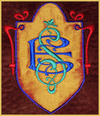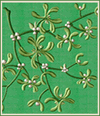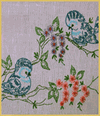Linen � Material & Care
Linen is a natural textile fiber, manufactured from the flax plant, Linum usitatissimum. Linen is costly to produce, yet it�s highly valued for its exceptional coolness and freshness in hot weather.
Textiles in a linen-weave texture, even when made of cotton, hemp and other non-flax fibers, are also sometimes improperly referred as "linens", while actually they�re not. So here we�re specifically referring to a material produced from flax plant.
Linen textiles appear to be some of the oldest in the world: their history goes back many thousands of years. At a certain period of time, linen even used to serve as currency in ancient Egypt. Egyptian mummies were wrapped in linen because it was seen as a symbol of light and purity, and as a display of wealth.
Today linen is usually an expensive textile. It has a long "staple" (individual fiber length) relative to cotton and other natural fibers. Of course not all linen is of the same quality � some of the finest linens are considered to be an European �MASTERS OF LINEN� line, and the age-old famous Egyptian linens.
Laundering
Be sure to read instructions regarding the specific product you purchase, if such is provided. Different linen qualities and blends may ask for a bit different care. Yet here are a few general suggestions:
Usually linen can be machine-washed without any problem, and even becomes more pleasant to wear and touch after numerous laundries. However it asks for quite a significant amount of water, so it may not be a good idea to wash linens in � machine mode. Be sure to give it the water and space.
Linen may be line-dried or machine-dried. Just be sure to remove the linen from the line or the dryer while it is still damp. If it dries thoroughly, it becomes brittle and takes several hours to recover its pleasant texture and softness.
Linen likes regular soap or gentle detergent. For white linens, you may use oxygen-type bleaches (chlorine bleaches can cause yellowing). Water temperature may be between warm to hot, depending on the specific item instruction. And be sure to wash away any soap or detergents with PLENTY of water, to avoid age spots!
Ironing
It�s recommended to iron linen while it�s still damp. This way it irons easily. Of course the iron must be clean and smooth, for easy and stainless ironing. The same is true about ironing board. You may use hot to very hot setting, depending on linen weight. The thicker the linen, the hotter your iron should be.
With steam iron, remember to put de-mineralized water inside. Mineral elements can cause ugly spotting. A heavy-duty steamer is required to remove wrinkles from heavier linens. Usually regular, non-pressure steam iron isn�t enough.
Light-colored linen should be ironed on the wrong side first, then on the right side. Dark linens - on the wrong side only. Iron linen until smooth, yet not completely dry, and once wrinkles are gone, hang to dry. When ironing an embroidered linen, put a soft towel over embroidered area, and iron via the towel.
Textiles in a linen-weave texture, even when made of cotton, hemp and other non-flax fibers, are also sometimes improperly referred as "linens", while actually they�re not. So here we�re specifically referring to a material produced from flax plant.
Linen textiles appear to be some of the oldest in the world: their history goes back many thousands of years. At a certain period of time, linen even used to serve as currency in ancient Egypt. Egyptian mummies were wrapped in linen because it was seen as a symbol of light and purity, and as a display of wealth.
Today linen is usually an expensive textile. It has a long "staple" (individual fiber length) relative to cotton and other natural fibers. Of course not all linen is of the same quality � some of the finest linens are considered to be an European �MASTERS OF LINEN� line, and the age-old famous Egyptian linens.
Laundering
Be sure to read instructions regarding the specific product you purchase, if such is provided. Different linen qualities and blends may ask for a bit different care. Yet here are a few general suggestions:
Usually linen can be machine-washed without any problem, and even becomes more pleasant to wear and touch after numerous laundries. However it asks for quite a significant amount of water, so it may not be a good idea to wash linens in � machine mode. Be sure to give it the water and space.
Linen may be line-dried or machine-dried. Just be sure to remove the linen from the line or the dryer while it is still damp. If it dries thoroughly, it becomes brittle and takes several hours to recover its pleasant texture and softness.
Linen likes regular soap or gentle detergent. For white linens, you may use oxygen-type bleaches (chlorine bleaches can cause yellowing). Water temperature may be between warm to hot, depending on the specific item instruction. And be sure to wash away any soap or detergents with PLENTY of water, to avoid age spots!
Ironing
It�s recommended to iron linen while it�s still damp. This way it irons easily. Of course the iron must be clean and smooth, for easy and stainless ironing. The same is true about ironing board. You may use hot to very hot setting, depending on linen weight. The thicker the linen, the hotter your iron should be.
With steam iron, remember to put de-mineralized water inside. Mineral elements can cause ugly spotting. A heavy-duty steamer is required to remove wrinkles from heavier linens. Usually regular, non-pressure steam iron isn�t enough.
Light-colored linen should be ironed on the wrong side first, then on the right side. Dark linens - on the wrong side only. Iron linen until smooth, yet not completely dry, and once wrinkles are gone, hang to dry. When ironing an embroidered linen, put a soft towel over embroidered area, and iron via the towel.




